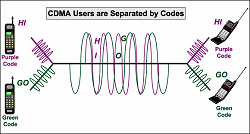Consider an analogy.
There are 20 people inside a room. They want to communicate each other. Assume one to one communication. What are the methods we can follow, so that everyone can communicate each other?
TDMA- Each pair will get 30 seconds to communicate. All pair should wait for their turn. They can speak only when their turn comes. What is the disadvantage of the system? Others are wasting their time when a particular pair is speaking. This is equivalent to Time Division Multiple Access.
FDMA- Each pair should communicate in different pitches. One pair one pitch other in some another pitch. The advantage is that, no one is wasting their time for others, but they must have the ability to speak in different pitches. It is complicated and when the number of people increases, it will become difficult to speak in different pitches.
CDMA- Each pair should communicate in different languages. What is the advantage here? We are not waiting for others, ie, there is no waste of time. We can speak in the same pitch, since the language is different.
 |
| FDMA, TDMA, CDMA Analogy |
In TDMA(Time Division Multiple Access),the bandwidth is just one channel that is timeshared between different stations.Each station is allocated a time slot during which it can send data and each station transmits its data in is assigned time slot.
 |
In CDMA(Code Division Multiple Access),one channel carries all transmissions simultaneously and using a unique code for each transmitted signal,the mobile and base station are able to distinguish between signals transmitted simultaneously over the same freuqency allocation.
In FDMA(Frequency Division Multiple Access),the available bandwidth of the common channel is divided into bands that are separated by guard bands(to prevent station interferences).Each staion is allocated a band to send its data and also uses a bandpass filter to confine the transmitter frequencies.
 |
| FDMA Bandwidth slicing |


is there any physical multiplexer in CDMA to multiplex the data into channel.
ReplyDelete